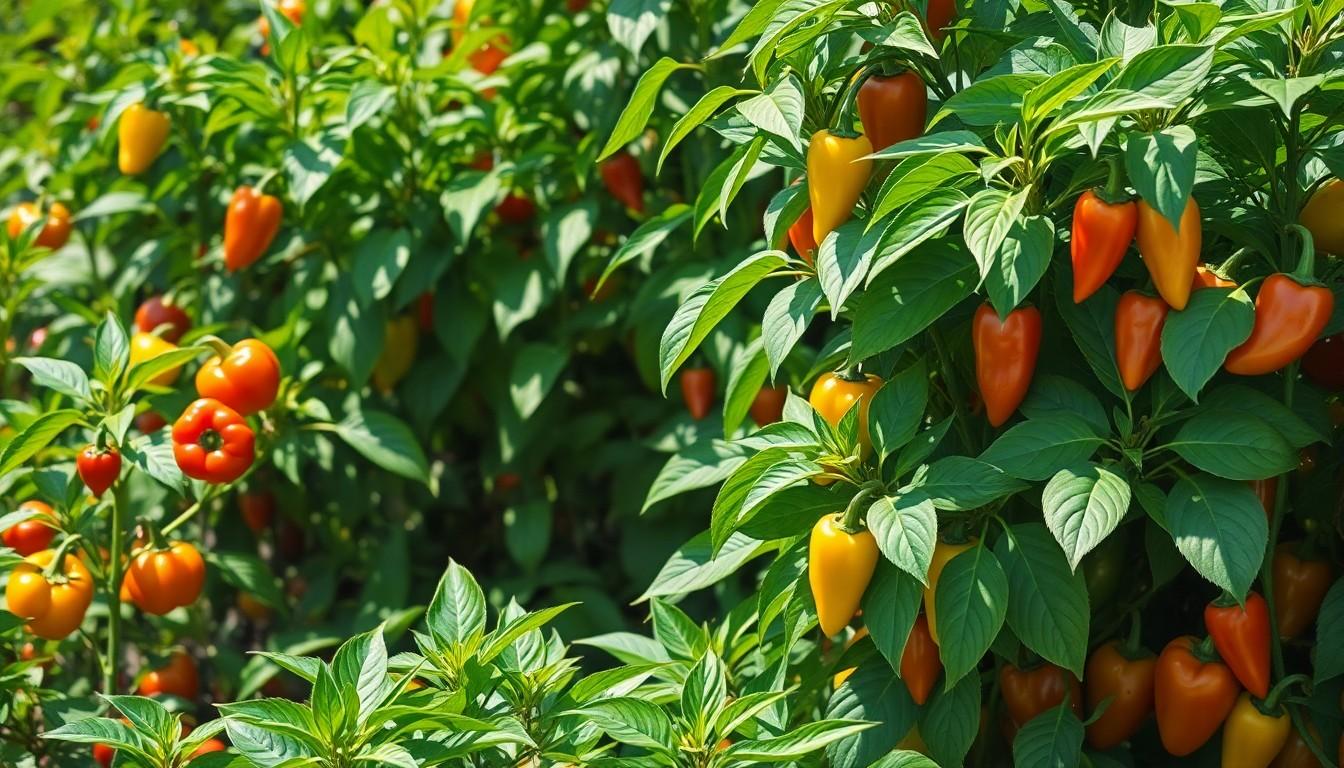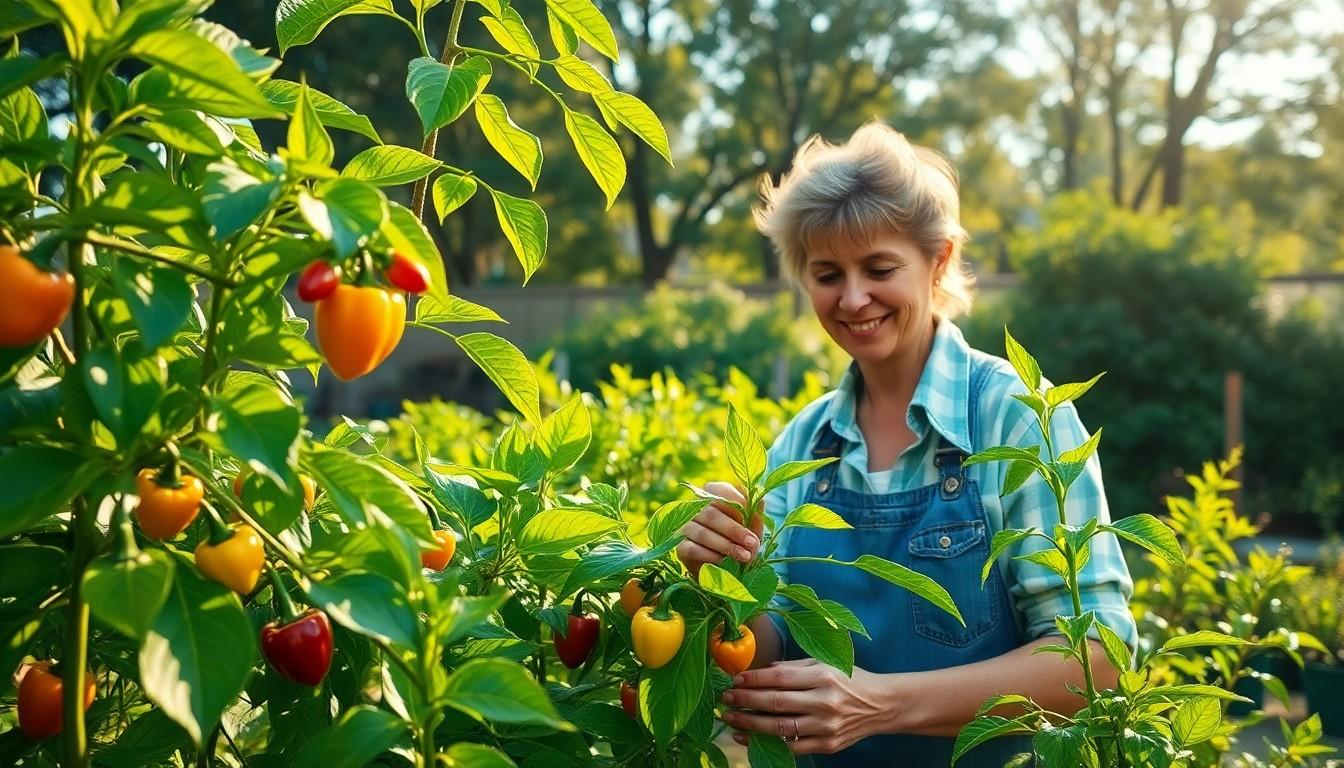Growing pepper plants can be a thrilling adventure, but it’s not all sunshine and rainbows. These feisty little beauties need the right care to flourish, and let’s face it, nobody wants a sad, droopy plant sulking in the corner. With a dash of humor and a sprinkle of knowledge, anyone can turn a pepper plant into a thriving superstar in their garden or kitchen.
Overview of Pepper Plant Care
Pepper plants require specific conditions to thrive, ensuring vibrant growth and a bountiful harvest. Start with selecting the right variety, as differences in peppers influence care methods. Choosing bell, jalapeño, or habanero peppers can determine the plant’s needs.
Light plays a crucial role in pepper plant care. These plants prefer full sun, with at least six hours of direct sunlight daily. Position them in a bright location to stimulate robust growth.
Watering habits affect the health of pepper plants significantly. Soil must remain consistently moist but not overly saturated. Weekly watering is typically sufficient, with adjustments made during dry spells.
Soil quality impacts growth and yield. Choose well-draining soil enriched with organic matter, promoting healthy root development. Fertilizing with a balanced formulation supports nutrient uptake, aiding flowering and fruiting.
Pest management is essential for preventing damage to pepper plants. Regularly inspect for aphids, spider mites, and other common pests. Using natural remedies or insecticidal soap helps maintain plant health.
Temperature requirements are paramount for optimal growth. Pepper plants thrive in warm conditions, ideally between 70°F and 85°F. Protect them from frost exposure to promote longevity.
By following these guidelines, growers can foster healthy, productive pepper plants. Adhering to specific care practices enhances the success of pepper cultivation, whether in a home garden or indoor environment.
Choosing the Right Pepper Variety

Selecting the appropriate pepper variety significantly impacts growth and care. Different types of peppers exhibit varied flavors, heat levels, and growing conditions, making it essential to choose wisely.
Popular Pepper Varieties
Bell peppers are known for their sweet flavor and versatility in dishes. Jalapeños, with their medium heat, add a kick to salsas and sauces. Habaneros stand out for their intense spiciness, perfect for those who enjoy heat. Other notable varieties include poblano peppers, prized for their mild flavor, and banana peppers, which offer a tangy taste. Each variety provides unique attributes, catering to diverse culinary preferences.
Factors to Consider When Choosing
Growing conditions significantly influence the choice of pepper variety. Light requirements vary among types; some thrive in full sun, while others prefer partial shade. Heat tolerance also matters; selecting a variety suited for the local climate ensures optimal growth. Disease resistance plays a critical role, particularly for gardeners facing specific regional challenges. Lastly, harvest time is essential; some varieties mature faster than others, allowing for different planting strategies to maximize yield.
Ideal Growing Conditions
Pepper plants thrive under specific conditions that encourage robust growth and fruitful yields. Understanding these ideal settings enhances care and maximizes success.
Light Requirements
Pepper plants need at least six hours of direct sunlight each day. Morning sun is particularly beneficial, as it helps to dry excess moisture on leaves. Lack of sufficient light may result in leggy growth and fewer fruits. Supplementing natural daylight with grow lights can support indoor cultivation. Both outdoor and indoor growers should monitor light exposure to ensure optimal development.
Soil Preferences
Well-draining, organic-rich soil garners the best results for pepper plants. A pH level between 6.0 and 7.0 promotes nutrient availability. Heavy clay soils or compacted materials restrict root growth and water access. Incorporating compost or aged manure enhances soil structure and fertility. Regular soil testing can guide fertilization practices, ensuring nutrient balance.
Temperature and Humidity
Pepper plants flourish in temperatures ranging from 70°F to 85°F. They tolerate lower nighttime temperatures but should avoid exposure to frost. High humidity levels support their growth, but excessively damp conditions may lead to disease. Maintaining good air circulation around plants helps reduce humidity-related issues. Monitoring local weather conditions keeps plants safe from sudden temperature drops.
Watering and Fertilization
Proper watering and fertilization are key for thriving pepper plants. Adhering to appropriate methods benefits overall growth.
Watering Techniques
Watering requires a balance. Soil should maintain consistent moisture without becoming waterlogged. Heavier watering is beneficial during initial growth stages, encouraging deep root development. Keeping soil slightly dry between watering helps prevent over-saturation. Adjusting frequency based on weather conditions enhances plant resilience. During hotter days, daily checks are necessary, and irrigation adjustments may follow. Employing soaker hoses or drip irrigation provides efficient moisture delivery. Early morning watering minimizes evaporation while ensuring hydration throughout the day.
Fertilizer Types and Schedules
Fertilization plays a significant role in pepper care. Organic options like compost and fish emulsion provide essential nutrients. Balanced fertilizers with equal nitrogen, phosphorus, and potassium ratios work effectively. Timing matters too; a feeding schedule every four to six weeks supports growth during the active season. Early growth benefits from high nitrogen formulas, while fruiting stages thrive on higher potassium and phosphorus levels. Mixing granular fertilizers into the top layer of soil enhances nutrient absorption. Monitoring plant response helps tailor approaches, ensuring optimal health.
Pest and Disease Management
Effective pest and disease management is crucial for maintaining healthy pepper plants. Regular assessments enable prompt identification of issues that may arise.
Common Pests
Aphids, spider mites, and whiteflies frequently target pepper plants. Aphids appear as small green or black insects, often congregating on new growth. Spider mites, tiny and web-spinning, lead to stippled leaves and can cause significant damage. Whiteflies, resembling small moths, also feed on plant sap, weakening overall vitality. Integrated pest management strategies can address these challenges effectively.
Preventative Measures
Implementing preventative measures significantly reduces pest threats. Regularly inspect pepper plants for signs of infestation, tackling issues early on. Maintaining good air circulation and using proper watering techniques helps prevent conditions that foster pest populations. Applying natural insecticidal soap can provide additional protection without harming beneficial insects. Creating an inviting environment for natural predators can also diminish pest numbers.
Harvesting and Storage
Harvesting peppers at the right time ensures maximum flavor and quality. Various pepper types signal readiness for harvest differently; for instance, bell peppers typically turn from green to their mature color, such as red or yellow. Jalapeños, on the other hand, are best harvested when firm and shiny, typically while they’re still green. Harvesting early tends to yield crunchy textures, while waiting a bit longer enhances sweetness and spiciness. Regularly checking for size and color helps determine the perfect moment for each variety.
When to Harvest
The optimal harvest time varies between pepper types. Bell peppers usually ripen within 70 to 80 days after transplanting, while jalapeños mature faster, often around 60 days. Habaneros require close to 90 days to fully ripen. For peak flavor, it’s best to pick them when they reach their desired color, size, and firmness. Observing the plant’s growth stages aids in identifying these signs.
Proper Storage Techniques
Proper storage extends the freshness of harvested peppers significantly. Refrigeration works well for short-term storage, with peppers lasting up to two weeks when stored in a crisper drawer. Wrapping them in a damp paper towel before placing them in a plastic bag helps retain moisture. For longer-term storage, freezing is advisable; blanching peppers for two minutes before freezing preserves flavor and texture. Vacuum sealing also effectively prevents freezer burn, keeping peppers delicious for up to six months.
Conclusion
With the right care pepper plants can flourish and provide a rewarding harvest. By understanding the specific needs of different varieties and maintaining optimal growing conditions it’s possible to cultivate vibrant plants that yield delicious fruits. Regular monitoring for pests and diseases is crucial to ensure continued health and productivity.
Embracing a balanced approach to watering and fertilization will further enhance growth and fruit quality. Whether growing peppers in a garden or indoors the journey is as enjoyable as the harvest itself. By following these essential care tips anyone can experience the satisfaction of nurturing thriving pepper plants.

